ArcadeDanger
Member
- Joined
- Dec 31, 2023
- Messages
- 23
One of my first computer related memories was from the Osborne 1 - my father bought one for his income tax business that he ran in West Covina, a suburb of Los Angeles in California. I remember sitting with him, typing up basic programs from books and magazines to run on it. He eventually got an external TV monitor for it, and a I also remember a printer buffer to be able to send jobs to the dot matrix printer and be able to continue using the computer (sometimes there was a lot of invoices to print and the computer could do nothing else than wait for the printer to finish). I of course played video games, ADVENT (Colossal Cave) being one of the games I recall playing.
A friend of mine mentioned this Osborne 1 that had been on display at his office for a while, and when he heard my personal attachment to it, he offered it to me. The story was that it belonged to his father, an engineer, who collected lots of older electronics. It looks like the earlier version of the OCC1, with the ribbon cable connector for the keyboard, the front fascia exposing more of the drives, the simpler brown case with decals and the keyboard clips on the side of the case rather than the top.
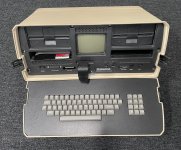

It hadn't been powered on in a long time and its working state was unknown. After reading a bit on the internet that most of the time the RIFA safety caps were way past their prime I decided to just shotgun re-cap the power supply with an order from Console5. Popped off the dials for contrast/brightness (which were very stubborn to come off) then took screws off the front. Dissasembly showed that there were a lot of missing screws, the PCB was dangling, so I wondered that it broke down and someone had worked on it, and then hastily re-assembled it when they couldn't get it working again. (Random note - If you're wondering about screw sizes, this unit uses 'standard' 6-32 x 3/8 (front fascia, PCB mounts, drives) and 8-32 x 3/8 (chassis to case screws)). That said, it looked complete as far as I could tell.
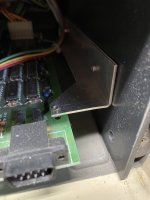
Re-capping the power supply was the right approach, the RIFA caps were all cracked and I'm sure would have smoked if I had tried to power it on. I tested the power supply unplugged from the rest of the components and I was getting good solid +5 vdc, -5vdc and +12vdc out while it was unloaded. Hooked everything up, discovered that the double density board was plugged incorrectly (off by 1 pin) which didn't let it boot up. After fixing that, I was pleasantly surprised to see signs of life.
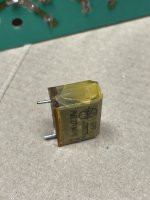
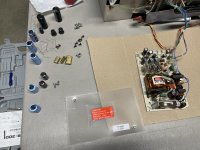
One of things that surprised me was the internal frame would sag towards the center quite a bit with all the components on it, I'm guessing this was how the original version was:
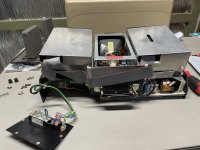 It came with some floppies. None of them would boot off the A: drive, clanking away and reporting an error over and over repeatedly. In my reading I did see that you could also boot off the B: drive by holding Shift-Quote and Return and found 2 of the 3 floppies would boot that way. Great progress! The following day I detached drive A: and tried to lube the scroll gear and move the head back and forth, in the random chance that such an easy fix could resolve the problem (I saw an 8bit guy video doing this and figured why not). Simple solution actually worked!
It came with some floppies. None of them would boot off the A: drive, clanking away and reporting an error over and over repeatedly. In my reading I did see that you could also boot off the B: drive by holding Shift-Quote and Return and found 2 of the 3 floppies would boot that way. Great progress! The following day I detached drive A: and tried to lube the scroll gear and move the head back and forth, in the random chance that such an easy fix could resolve the problem (I saw an 8bit guy video doing this and figured why not). Simple solution actually worked!
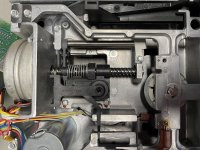
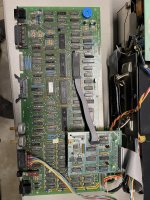
At this point, everything was functional, which I thought was amazing. I saw the posts where the Shugart drive was replaced with a Floppy Emulator, so I decided that would be a nice upgrade and let me get software loaded onto it a little easier than with older 5 1/4" floppies. I ordered a GoTek Floppy Drive Emulator 435 MCU w/ Rotary Encoder OLED FlashFloppy in black, the Osborne 1 adaptor and a USB key with Osborne software loaded. A friend of mine kindly printed the mounting bracket an available on Thingyverse and everything assembled perfectly, worked on first try and only needed to fix one line in the ff.cfg file to flip and use the right font size for the OLED display on the GoTek. I'm calling this done and am looking forward to playing some text adventures like I did as a kid.
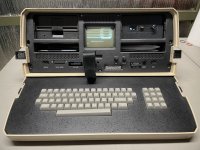
Some future work for this one may be an attempt to retro-brite the case, and see if I stumble into a 80 column board to be able to plug an external monitor.
Thanks to folks who shared their posts about the Osborne 1, I think it really helped me figure out what to do and get this running so quickly again.
A friend of mine mentioned this Osborne 1 that had been on display at his office for a while, and when he heard my personal attachment to it, he offered it to me. The story was that it belonged to his father, an engineer, who collected lots of older electronics. It looks like the earlier version of the OCC1, with the ribbon cable connector for the keyboard, the front fascia exposing more of the drives, the simpler brown case with decals and the keyboard clips on the side of the case rather than the top.


It hadn't been powered on in a long time and its working state was unknown. After reading a bit on the internet that most of the time the RIFA safety caps were way past their prime I decided to just shotgun re-cap the power supply with an order from Console5. Popped off the dials for contrast/brightness (which were very stubborn to come off) then took screws off the front. Dissasembly showed that there were a lot of missing screws, the PCB was dangling, so I wondered that it broke down and someone had worked on it, and then hastily re-assembled it when they couldn't get it working again. (Random note - If you're wondering about screw sizes, this unit uses 'standard' 6-32 x 3/8 (front fascia, PCB mounts, drives) and 8-32 x 3/8 (chassis to case screws)). That said, it looked complete as far as I could tell.

Re-capping the power supply was the right approach, the RIFA caps were all cracked and I'm sure would have smoked if I had tried to power it on. I tested the power supply unplugged from the rest of the components and I was getting good solid +5 vdc, -5vdc and +12vdc out while it was unloaded. Hooked everything up, discovered that the double density board was plugged incorrectly (off by 1 pin) which didn't let it boot up. After fixing that, I was pleasantly surprised to see signs of life.


One of things that surprised me was the internal frame would sag towards the center quite a bit with all the components on it, I'm guessing this was how the original version was:
 It came with some floppies. None of them would boot off the A: drive, clanking away and reporting an error over and over repeatedly. In my reading I did see that you could also boot off the B: drive by holding Shift-Quote and Return and found 2 of the 3 floppies would boot that way. Great progress! The following day I detached drive A: and tried to lube the scroll gear and move the head back and forth, in the random chance that such an easy fix could resolve the problem (I saw an 8bit guy video doing this and figured why not). Simple solution actually worked!
It came with some floppies. None of them would boot off the A: drive, clanking away and reporting an error over and over repeatedly. In my reading I did see that you could also boot off the B: drive by holding Shift-Quote and Return and found 2 of the 3 floppies would boot that way. Great progress! The following day I detached drive A: and tried to lube the scroll gear and move the head back and forth, in the random chance that such an easy fix could resolve the problem (I saw an 8bit guy video doing this and figured why not). Simple solution actually worked!

At this point, everything was functional, which I thought was amazing. I saw the posts where the Shugart drive was replaced with a Floppy Emulator, so I decided that would be a nice upgrade and let me get software loaded onto it a little easier than with older 5 1/4" floppies. I ordered a GoTek Floppy Drive Emulator 435 MCU w/ Rotary Encoder OLED FlashFloppy in black, the Osborne 1 adaptor and a USB key with Osborne software loaded. A friend of mine kindly printed the mounting bracket an available on Thingyverse and everything assembled perfectly, worked on first try and only needed to fix one line in the ff.cfg file to flip and use the right font size for the OLED display on the GoTek. I'm calling this done and am looking forward to playing some text adventures like I did as a kid.

Some future work for this one may be an attempt to retro-brite the case, and see if I stumble into a 80 column board to be able to plug an external monitor.
Thanks to folks who shared their posts about the Osborne 1, I think it really helped me figure out what to do and get this running so quickly again.
